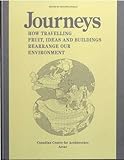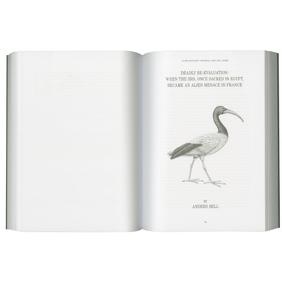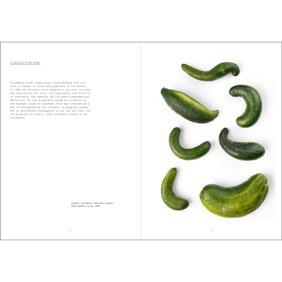
Sin lugar a dudas uno de los centros más interesantes respecto a la difusión y exhibición de la arquitectura contemporánea es el CCA (Canadian Centre for Architecture) y es que su director, Mirko Zardini, entiende y nos transmite la exhibición de la arquitectura como una práctica en la que se reflejan nuevas visiones de la misión global de la misma, promoviendo interesantes retrospectivas del papel de la arquitectura, explorando sus límites cada vez más difusos y generando enriquecedores debates.
Un ejemplo de estas rompedoras exposiciones es JOURNEYS «how traveling fruit, ideas and buildings rearrange our environment», resultado de un proyecto de investigación que explora las sinergias arquitectónicas generadas por el incremento de la movilidad global. La muestra indaga en el deambular del conocimiento, en el viaje de las semillas de la razón natural, en el intercambio de bagajes culturales y experiencias que se dan cuando los humanos nos movemos de un lugar a otro y cómo todo ello influencia la reconfiguración física de los distintos entornos y comunidades. Mediante el desarrollo de varios de estos temas de forma paralela, Journeys esboza ante el espectador una red de situaciones reales (cada una con un marco físico-temporal específico) vinculándolas a diversos conceptos relacionados con la práctica actual de la arquitectura; analizando así y decodificando visualmente cómo estos flujos, devenires y migraciones cambian la sociedad y sus ecosistemas de forma fortuita y sorprendente.
El catálogo de Journeys, copublicado por el CCA y Actar y editado por Giovanna Borasi, es el resultado de la compilación de dieciséis historias de ficción que complementan de forma brillante la exhibición, siguiendo la línea de las exposiciones del CCA, en las que las publicaciones que acompañan a las mismas no son simplemente un compendio de fotos de lo expuesto, sino una herramienta que ayuda a construir el marco crítico que la sustenta y a la vez forma parte de ella.
Cada una de las historias que componen Journeys está enmarcada en un determinado enclave espacio-temporal e ilustra un concepto relacionado con la movilidad y transformación, que se engloba dentro de la red de causas-efectos que plantea de forma abstracta la publicación.
Más allá del interesante análisis de cómo el desplazamiento de bienes, ideas, tipos arquitectónicos, herramientas y conocimientos experimentados transforman lugares específicos y sus entornos, cada historia es un pequeño dulce digno de ser saboreado. Cada una de ellas, redactada por expertos de múltiples disciplinas específicamente relacionadas con cada entorno, concepto o transformación, parte de una historia de ficción con carácter didáctico, basada en datos y hechos reales . La lectura a lo largo de la publicación desvela entre ellas relaciones, contrastes y semenajanzas, esbozando un modelo de cambio inevitablemente global que se ha ido gestando sigilosamente desde hace tiempo.
Como cierre, un link al backstage de la publicación, otro a una de las historias y el índice de conceptos e historias de Journeys. (Eso sí, en ingles y después del salto).




Classification (Mobility determined by regulation changes the approach to production, and limits diversity): 1988 E.U. regulations dictated the dimensions of the best quality cucumber. Those that did not fit the classification precisely had to be re-classified as ‘intended for processing’, determining the variety of fruits and vegetables that we grow and eat.
When a cucumber is not a cucumber: an E.U. tale of customs and classification. – Lev Bratishenko
Wayfinding (Movement across a landscape can be determined by oral histories, instructive toponymy or a physical relationship with a territory): For the Inuit, the relationship with the land is a matter of knowing thousands of sequential place names that are learned over the course of journeys and discussions with elders. Places are described in terms of how one gets there, what one sees on the horizon, and which way the prevailing winds blow. These methods provide an alternate perspective on the territory.
The prairie is vast and endless, until it isn´t: a michif story. – Jeam Teillet
Definition (An architectural type adapts its meaning and form across different cultures and historical periods): The definition of the bungalow has evolved and adapted several times since it originated in Bengal, India. In early 20th century Africa and India, the bungalow was the most desirable type of building, occupied by Europeans and senior government officials. The name also applied to holiday homes or affordable lodgings in England and North America.
Oh Bungalow, born by the bay of Bengal, you conquered an empire-an then the world-redefining success every step of the way! – David Howes
Cycle (A continuous influx of temporary workers in the informal economy of one country changes the way of life in another): In 2001, Senegalese economic migration to Italy was estimated at 80,000 to100,000 people. Typically each family member spends 3-5 years in Italy before returning home. Goods, materials and money valued at approximately $400m per year are sent back to Senegal and account for the substantial development and urbanization of the country.
The back-and-forth cycle: how temporary senegalese workers live on the edges of italian society and rapidly transform the built environment back home. – Ian Chodikoff
Interpretation (New arrivals transform a modernist neighbourhood through unintended uses): In the mid-70s, an ambitious 1960s housing project outside Amsterdam became home to Surinamese and other immigrants. They adapted the modern building to their needs and developed informal uses for the public spaces, such as markets and community centres.
Interpreting modernism: how an Amsterdam housing development changes when Surinam gains independence. – Wouter Oostendorp and Jouke Sieswerda
Experimentation (A culture of innovation flourishes when transplanted): In the 1950s Japanese migrants formed new communities in Bolivia, where a revolution and agrarian reform had opened vast new tracts of land for farming. The tradition of experimental agriculture brought by the new inhabitants transformed the landscape, both by the introduction of new crops and through imported techniques, such as wet-rice farming.
How rice, persimmons, soy and a whole host of other crops from japan reshaped the bolivian countryside. – Kozy Amemiya
Compromise (Habits of newcomers weave unexpected solutions into an existing urban fabric): An earthquake in 1981 left the centre of the Sicilian town of Mazara largely abandoned. Historically one of Italy’s most important fishing harbours, it now supports some 4,000 fishermen, mostly immigrants. The immigrants dominate the centre (casbah) and the structure, buildings and public spaces of Mazara have been re-negotiated to accommodate this new community.
Compromise in the casbah: how the residents of a sicilian town navigate several languages and many different ideas about how to use space. – Giovanna Borasi
Configuration (The accumulation of buildings from other places rearranges an established urban grid): Between 1954 and 1975, the provincial government of Newfoundland encouraged 300 isolated communities (around 30,000 people) to resettle in central areas. The higher housing prices in these areas often made the purchase of new homes unrealistic for newcomers. Many economized by transporting their houses by sea, which created dramatic change in the built environment of Newfoundland.
Re-configurations: a town in newfoundland grows when houses are floated in from far-flung outports. – Maureen Power
Inheritance (Architecture built from memory recalls the social structure left behind): From 1816-47, former American slaves, often freed on condition that they emigrate, were encouraged to settle in Liberia. Approximately 17,000 made the journey and founded cities with buildings which reflected their American origins.
Returning to a new land: how the architecture of the old south mate its way to Arthington, Liberia. – Bernard L.Herman
Typology (A communication infrastructure tied to the circumstances of migration takes similar forms globally): Small shops providing telecommunication services are found in urban centres worldwide, where they offer long-distance calling and internet access for travellers, immigrants and temporary workers. Although these shops appear all over the world, they have a common typology: they are simultaneously generic and independent.
Call shops: a new architectural typology for calling home. – Riitta Oittinen
Opportunity (The forced relocation of a town offers the potential to try an innovative form of urbanism): Proposals to open the St Lawrence River to ocean-going shipping in Canada in the 1950s involved the relocation of several Ontario communities. The town of Iroquois engaged British architect Wells Coates to design a new town for them. His modernist proposal was never realized but remains interesting for its imaginative reconception of urban design in Canada.
On the move of iroquois, Ontario: how choosing a site to the east offers an opportunity for futuristic living. – Peter Sealy
Negotiation (Local ambition, partnered with substantial foreign investment, impacts on the social and built environment for an entire country): The capital of the Republic of the Congo was damaged by civil wars in 1992 and 1997 and is being rebuilt. The presence of the Chinese government and Chinese companies has been instrumental to the development of this city, Brazzaville, which is taking form as a negotiation between local political forces and the Chinese.
Learning ideograms: a story of how Congo´s brazzaville is being built anew by chenese companies. – Serge Michel
Expertise (The transfer of knowledge and experience gives a new character to a centre of industry): Skilled Italian stonemasons and cutters were recruited by American immigration companies in the 1880s and 1890s to work in the booming granite and marble quarries of New England. In the town of Barre, Vermont, the industry developed in a special way, not just as a source of raw materials, but also finished products.
Expatriate expertise: when the arrival of skilled italian workers transformed the vermont granite industry. – Ilaria Brancoli Busdraghi
Value (A change of location leads to a radical shift in significance): The Sacred Ibis once occupied a principal role in ancient Egyptian mythology and ritual, where it was associated with Thoth, the god of writing and culture. Now transplanted to France, the bird is instead perceived as an invasive species and a threat to that country’s biodiversity.
Deadly re-evaluation: when te Ibis, once sacred in Egypt, became an alien menace in France. – Anders Bell
Drift (The vagabondage of seeds shapes our environment in ways that are not predetermined): The coconut is a global traveller, riding the ocean currents at the whim of the weather and tides. With its tough fibrous husk and air-filled seed, it can float great distances and germinate if it reaches land within four months of leaving its source. Laws cannot curtail the movement of the coconut.
Perplexing peregrinations: on the trail of drifting coconuts. – Curtis C.Ebbesmeyer
